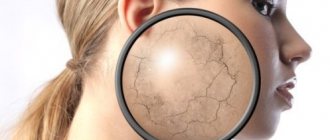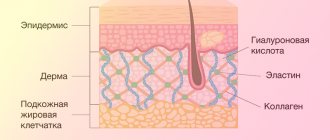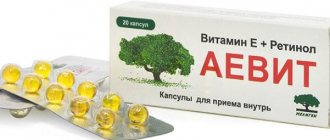Last update: 03/03/2021
With the onset of spring, many of us notice a deterioration in our health - weakness, fatigue, irritability appear, mood decreases, and sleep is disturbed. Changes also affect appearance - hair becomes dull and brittle, skin becomes dry and often flaky, rashes and redness appear. All these unpleasant symptoms signal to us about the development of a common seasonal disease - hypovitaminosis or vitamin deficiency.
Vitamin deficiency on the skin of the hands
One of the most unpleasant forms of vitamin deficiency is vitamin deficiency of the skin of the hands. It manifests itself as dryness, peeling, itching, cracking of the skin, causing a lot of discomfort. In addition, cracks that appear on the hands increase the risk of various skin infections.
It is important to understand that vitamin deficiency in the hands of children and adults is not an aesthetic problem, but a serious disease. It occurs due to a lack of vitamins in the body, usually of groups A, B or E. Often the signs of vitamin deficiency are similar to allergies or fungal skin lesions, so people who try to independently diagnose and treat the disease often use drugs that do not improve the condition at all. , but on the contrary, aggravating their condition.
Nourishing and moisturizing creams: key characteristics
There are many factors that contribute to dry skin, which can be divided into external and internal. External factors include errors in care, weathering, chlorinated water, and lack of fluid in the body. Also, the condition of the hands is largely influenced by seasonality. Dryness often appears at the end of winter or early spring, when the skin suffers from a lack of vitamins and sun.
Among the internal causes of dryness are the following:
- Allergic reactions
- Slow metabolism
- Skin diseases
Regardless of the reasons for the problem, it is worth reconsidering your care and usual lifestyle.
Causes of vitamin deficiency
The causes of this form of vitamin deficiency may be the following factors:
- unbalanced diet;
- abuse of refined foods;
- monotonous diet;
- stress, emotional turmoil;
- bad habits (smoking, alcohol abuse);
- physical inactivity;
- prolonged physical and mental fatigue;
- improper functioning of the gastrointestinal tract;
- chronic lack of sleep;
- use of antibiotics.
Treatment of vitamin deficiency in the skin of the hands
If such a nuisance as vitamin deficiency of the hands happens to you, there is no need to panic. A timely diagnosed disease responds well to treatment, and improvement occurs quite quickly.
To quickly treat vitamin deficiency in the skin of the hands, it is necessary, first of all, to identify the cause of the disease. If it is a disturbance in the functioning of the gastrointestinal tract, you should consult a specialist and undergo a course of treatment. But in most cases, it is enough to simply review and adjust your diet, enriching it with essential vitamins. In the treatment of vitamin deficiency, several methods can be distinguished, which often should be combined:
- Balanced diet.
- Taking pharmaceutical medications containing vitamins.
- The use of external agents for local help with vitamin deficiency of the hands.
- Traditional methods of obtaining vitamins.
- Correct daily routine.
- Walks in the open air.
- Sports activities.
- Rejection of bad habits.
Nutrition for vitamin deficiency of the hands
Proper, balanced nutrition is the key to the prevention and rapid treatment of vitamin deficiency. Since this form of the disease, such as vitamin deficiency of the hands, speaks primarily of a lack of vitamins of groups A, B and E in the body, doctors recommend consuming foods rich in these particular vitamins.
The diet must include:
- meat, fish, seafood, eggs;
- legumes, grains, fermented milk products (cottage cheese, cheese, fermented baked milk, yogurt, sour cream);
- fresh fruits and vegetables, nuts.
It is better to replace refined drinks with a high sugar content with juices, fruit drinks and compotes, preferably homemade, without preservatives.
Taking a multivitamin complex
Taking multivitamin complexes can provide quick help in the fight against vitamin deficiency. Today the market offers a huge number of high quality and effective products. These complexes are pure synthetic chemical compounds containing the necessary balanced set of vitamins and microelements. A specialist should recommend such drugs to each individual individually.
Application of external skin care products
Skin care products that moisturize, nourish and protect the skin of the hands experiencing stress and discomfort will help to significantly alleviate and quickly improve the condition of the skin with vitamin deficiency on the hands.
One of the most effective products in this spectrum can rightfully be called La Cree cream for dry skin. It is intended to eliminate the causes and consequences of dry skin, including vitamin deficiency. The cream moisturizes the skin and restores its water-lipid balance. The product also protects the skin from loss of its own moisture and negative environmental influences in cold and windy weather. By carefully caring for your hands, the cream will have a healing effect, because nutrients will be delivered locally to problem areas of the skin.
The product contains jojoba, shea and wheat germ oils, rich in vitamins A and E, which help normalize the water-lipid balance of the skin, soften and nourish it, protecting it from peeling and drying.
Beeswax, another component of the healing cream, is a real natural resource of vitamin A. It has excellent nourishing, softening, healing and anti-inflammatory properties and has a restorative effect on dry and very dry damaged skin of the hands.
Seed and licorice extracts, rich in vitamins A and C, flavonoids and essential oils, relieve inflammation and itching, eliminate redness and flaking of skin injured by vitamin deficiency.
Vitamins for hand skin against flaking and dryness
Healthy skin requires nutrients and water every day.
What vitamins are most needed for the skin of the hands:
- Vitamin A effectively fights external signs of aging, accelerates recovery processes, and helps lighten age spots;
- biotin prevents dryness and increases skin elasticity;
- ascorbic acid promotes effective hydration and lightens age spots on the hands;
- Vitamin B1 increases skin elasticity and relieves minor irritations;
- Vitamin E prevents dehydration and accelerates recovery processes.
Traditional methods of obtaining vitamins
Traditional medicine offers us many effective remedies to combat vitamin deficiency in the skin of the hands. They can be divided into two groups - local and taken orally.
Fruit masks
Applications made from fruit mass are very useful for vitamin deficiency in the hands. To prepare a vitamin fruit porridge, take a mixture of chopped apple, banana and peach (you can replace it with kiwi or pear), add 1 teaspoon of unrefined olive or flaxseed oil, mix, apply to inflamed areas. After 25 minutes, rinse the mixture with warm water.
Mask with yolk
The following mask is perfect for renewing skin cells: mix one yolk of a chicken egg (preferably homemade or farm), 1 tbsp. a spoonful of wheat germ oil and 1 tbsp. a spoonful of honey. Apply the mixture to the skin of your hands, gently massaging them until completely absorbed. After 15 minutes, wash off excess mask with warm water without soap.
Herbal infusions
In case of severe irritation, peeling and cracking of the skin of the hands, you can use baths of herbal infusions. Take 1 teaspoon each of dried chamomile, string, linden and sage flowers, pour boiling water and let it brew for 20 minutes. Place your hands in the warm infusion and hold until it cools. It is better to use thick ceramic dishes for such baths, so the herbal infusion will remain warm longer, this will enhance the effect of the procedure.
Potato decoction
Potato decoction baths are also useful. After preparing potatoes for dinner, do not pour the broth into the sink, but, after cooling it a little, make a bath for your hands - they will thank you!
Just remember that you should not wash your hands immediately after such a procedure, just gently pat them dry with a soft towel.
Folk recipes for decoctions and drinks for the treatment of vitamin deficiency in the hands
Homemade vitamin cocktails will provide you with effective help in the fight against such an unpleasant ailment as vitamin deficiency of the skin of the hands. Honey is a mandatory component of these medicinal drinks.
Here are some examples of recipes:
- Dilute 200 g of honey in 500 ml of warm boiled water. Add pureed currants to the resulting liquid and stir the mixture until smooth. Take half a glass of the prepared drink several times a day.
- Dissolve 50 g of honey in one glass of warm water. Add freshly squeezed juice of one lemon and juice of 1 kg of carrots. Drink this tasty drink several times a day, and you will quickly cope with vitamin deficiency in your hands.
Herbal decoctions are also an effective remedy for vitamin deficiency in the hands. They contain raspberry leaves, lingonberries, black currants and dried rose hips.
To prepare a healing infusion, take 1 teaspoon of each component, pour into a thermos and pour 2 cups of boiling water. Let the drink steep overnight (at least 8 hours), then you can drink it throughout the day instead of tea.
The skin of the hands of medical workers suffers due to frequent washing, treatment with antiseptics, and wearing gloves. Alcohol-containing products deprive the skin of its protective hydrolipidic layer; it does not breathe in gloves. Dryness, peeling, irritation, cracks appear. A cosmetologist and nutritionist advise how to restore the skin of your hands.
Cosmetologist of the paid consultative and diagnostic department of the Minsk Regional Dermatovenerological Dispensary Natalya Palantsevich The best cream?
With dexpanthenol or urea - Among the best means for restoring damaged epidermis and saturating it with moisture are those based on dexpanthenol. In the skin, this substance is converted into pantothenic acid, or vitamin B5. Pantothenic acid stimulates the renewal of the epidermis, normalizes metabolism in cells, and helps with irritation and cracks. Plus, dexpanthenol rejuvenates the skin, as it increases the strength of collagen fibers. Cream, gel or ointment based on it can be used for a long time, applied 1–2 times a day,
- says Natalya Palantsevich, a cosmetologist at the paid consultative and diagnostic department of the Minsk Regional Dermatovenerological Dispensary
.
The Belarusian gel with dexpanthenol has proven itself well. The product soothes irritations, eliminates dryness and roughness, and heals microdamages. The gel absorbs moisture and softens the skin, creating a protective layer on it without feeling sticky or greasy. It is applied to damaged areas several times a day, depending on need.
In addition, the composition includes glycerin, which saturates well with moisture, eliminates flaking, increases elasticity and improves the appearance of the skin.
To care for dry and sensitive hand skin, the specialist advises using products with urea. In the cream, look for this ingredient called Urea. Urea effectively moisturizes, reduces irritation and promotes cellular renewal. To improve the condition of dry skin, the product should contain 5% urea.
— In the pharmacy you can find a cream with urea (3%) in combination with glycerin (3%) and allantoin (0.1%). A product with this composition intensively moisturizes the skin and heals microcracks,
- Natalya Palantsevich emphasizes.
— Plus, the cream is quickly absorbed and does not leave a sticky film.
Beautician recommends homemade masks
- Glycerin
Moisturizes the skin, prevents cracks and heals minor wounds. Can be done 1-2 times a week.
To a teaspoon of glycerin, add 2 teaspoons of distilled water, a teaspoon of liquid honey and a teaspoon of crushed oatmeal. Mix thoroughly. Apply to hands for 30 minutes. Rinse off with warm water.
- Potato
Heals cracks, smoothes and rejuvenates the skin. Use 1-2 times a week.
Add 2 tablespoons of sour cream and half a teaspoon of sea buckthorn oil to 1.5 cups of warm puree. Mix well. Immerse your hands in the resulting mixture for about 15 minutes. Rinse off with warm water.
- Sea buckthorn
Well moisturizes and restores cracked skin. Use 2-3 times a week.
Mix the yolk, a teaspoon of sea buckthorn oil, 1/4 cup of olive oil, a tablespoon of honey. Apply the mixture to your brushes for 30 minutes. Rinse off with warm water.
Ekaterina Protasova, a nutritionist at the Vitamin food plant and chief freelance nutritionist at the Ministry of Health, told us what foods to add to your diet for dry skin on your hands.
Chief freelance nutritionist of the Ministry of Health Ekaterina Protasova
The main thing is clean drinking water, at least a liter per day. Plus other liquids. In total, approximately 25 ml of liquid per kilogram of body weight per day.
Vitamins C, E and A contribute to skin hydration and rejuvenation.
They regulate the production of collagen, which accelerates the healing of cracks and increases the protective properties of the skin.
Green vegetables, berries, especially black currants and sea buckthorn, citrus fruits, bell peppers, and rose hip decoction are rich in vitamin C. Now the healthiest thing to eat is frozen vegetables and berries or this year’s harvest.
- Vitamin A
is found in orange and yellow fruits and vegetables, and in green vegetables.
Vegetable oils and nuts are rich in vitamin E.
Those who smoke should pay special attention to vitamins. Tobacco smoke causes dryness, peeling and irritation of the skin, and premature aging.
Proteins promote collagen synthesis. About 60% of the diet should be proteins of animal origin - poultry, fish, lean meat, eggs and dairy products, 40% - of plant origin. Choose legumes, nuts and seeds. The most healthy and affordable are beans, peas, chickpeas and lentils.
Omega-3 fatty acids, which are rich in fatty fish, combat dryness and irritation of the skin. Calcium retains moisture in the skin. Therefore, consume more dairy products (up to 500 g per day), add pre-soaked sesame seeds to your diet (up to 30 g per day).
Intestinal microflora participates in the synthesis of vitamins. Eat vegetables, fruits, berries, seeds, and dairy products that will normalize its condition.
And as little refined foods as possible - sweets, starchy foods. All of them cause dry skin and accelerate aging.
- Use natural soap based on vegetable fats, possibly with glycerin or olive oil.
- Replace your moisturizer with a nourishing one, preferably with oils.
- Avoid washing your hands in water that is too hot or too cold to avoid damaging your skin.
- Blot the skin with a towel rather than rubbing it (this will prevent cracks from occurring).
- Wear gloves on clean, dry hands. This will reduce the risk of skin irritation. After removing the gloves, wash your hands and apply the cream.
Daily regimen for vitamin deficiency
Compliance with the daily regimen for a disease such as vitamin deficiency, in any form, is of great importance. Getting enough sleep, walking in the fresh air, playing sports, sunbathing - all these factors will help prevent the disease or cope with it if it already exists.
Giving up bad habits will also help overcome vitamin deficiency, improve overall health, increase immunity and resistance to seasonal respiratory diseases.
Vitamin deficiency on the skin of the hands in children
Unfortunately, such an unpleasant disease as vitamin deficiency of the skin of the hands is quite common in children, causing them a lot of suffering and anxiety. The child becomes capricious and irritable, appetite and sleep deteriorate, and this is not surprising, because the delicate baby skin is so sensitive, and the manifestations of the disease on it cause pain and itching for the baby.
If vitamin deficiency is accompanied by rashes, ulcers, irritation, cracking of the skin on the hands and other parts of the body, then parents need to be especially vigilant and in every possible way protect the baby from infection, which can aggravate the course of the disease.
The baby’s diet should also be enriched with food containing vitamins A and B. Of course, if vitamin deficiency appears on the child’s skin, it is necessary to consult a doctor, who should individually select a comprehensive treatment. It will probably include taking multivitamin preparations, a special diet enriched with vitamin products, and local treatment of inflamed areas of the skin.
What can be done at home if the problem is vitamin deficiency on the skin of a child’s hands? Traditional medicine offers many recipes for treating this disease.
- Bathing in herbal decoctions of chamomile and string will be effective. They will help relieve itching and irritation, and soothe the baby's inflamed skin. It is not difficult to prepare such a decoction: pour 1 tablespoon of dried chamomile and chamomile flowers into a thermos, pour boiling water over it, and let it brew for several hours. Pour into bathing water.
- All kinds of vitamin cocktails from different fruits, fruit drinks and juices can help children. When prescribing them, you must remember that many products, such as some fruits and honey, can cause severe allergies, so they should be used very carefully and only on the recommendation of a specialist. The younger the child, the greater the risk of allergic reactions to various foods.
Of course, it is easier to prevent the development of vitamin deficiency in a child than to treat the disease. Therefore, it is very important to understand in time whether there are not enough vitamins in the baby’s body. Remember, timely diagnosis by a specialist will help you quickly and effectively cope with vitamin deficiency and prevent it from harming the child’s health.
Peeling skin on the hands, causes
Redness and peeling of the hands are primarily caused by dry skin. Almost all women face this problem, despite the variety of cosmetic products. The reason is that there are almost no sebaceous glands on the skin of the hands, and the moisture content is noticeably lower than, for example, on the skin of the face. That is why the skin on your hands needs special daily care that can protect it from peeling and premature aging.
The causes of peeling of the palms of the hands and fingers are divided into external and internal.
External ones include:
- interaction with aggressive chemicals - even antimicrobial and deodorizing soap can dry out the skin, not to mention detergents for washing dishes, laundry or cleaning plumbing, so it is recommended to use soap with moisturizing components, and wear rubber gloves when contacting cleaning products;
- towel - if you dry your hands roughly after washing, the skin is damaged and loses moisture, it is better to blot them carefully;
- weather conditions - sun, wind, cold - all this negatively affects the skin of the hands and additionally dries it, so it is recommended to wear gloves and apply sunscreen in sunny weather;
- temperature changes - when in the fall or winter your hands move from the cold into a heated room;
- frequent contact with water - this very often causes peeling of the skin on the fingers, to avoid this you need to wet your hands well after contact with water and apply a protective cream;
- illiterate care - it is not enough just to smear your hands with cream, first you need to clean them, then nourish and moisturize them.
The situation is more complicated if the causes of peeling hands are related to internal processes of the body. These may include:
- the use of certain medications, such as antibiotics;
- allergies to ultraviolet radiation, cold, etc.;
- development of hypovitaminosis;
- lack of vitamins;
- various pathologies of internal organs;
- development of dermatitis, psoriasis, eczema;
- lesions of the skin of the hands by parasites, fungi, scarlet fever, parasites.
To get rid of peeling skin on the palms of the hands and peeling of the fingers, first of all, you need to correctly determine the cause of its occurrence. If these are external reasons, then it is enough to pay more attention to hand skin care and protection. And if there are internal reasons, only a doctor can prescribe treatment.
Clinical researches
Conducted clinical studies prove the high efficiency, safety and tolerability of the products. The products are suitable for daily care of adult and children's skin with mild to moderate forms of atopic dermatitis and during remission. As a result of therapy, a decrease in the activity of the inflammatory process, a decrease in dryness, itching and flaking was noted.
The brand's products are recommended by the Union of Pediatricians of Russia.
Sources:
- Yukhtina N.V., Modern ideas about atopic dermatitis in children
- Kamasheva G.R., Khakimova R.F. Valiullina S.A., Methods for assessing the severity of atopic dermatitis in young children, Dermatology journal, 2010
- Kovyazina N.A., Fedosimova N.A., Illek Ya. Yu. Diagnosis of atopic dermatitis in young children, Vyatka Medical Bulletin, 2007
Retinol (vitamin A) in cosmetics
The cosmetics market is developing faster than any other. Our grandmothers never dreamed of the amount of cosmetics that every self-respecting woman has today. Even if you are not a beauty blogger, you probably have at least 10 skincare products on your bathroom shelf.
However, despite such powerful care, almost every woman has encountered the fact that the product does not work as desired, or, worse, irritation occurs, dryness and sensitivity worsen, etc. For example, after using retinoids instead of a lifting effect and recovery, you can easily get redness, peeling and pigmentation. We will now tell you why this happens and how to avoid it.
The correct form of retinol
In order to get a rejuvenating effect, you should choose both a working and a safe form of retinoids. To understand the issue, let's look at the chain of transformation of retinoids on the skin:
Retinyl Esters (like retinyl palmitate) > Retinol > Retinaldehyde/Retinal > All-Trans-Retinoic-Acid/Tretinoin.
Retinyl palmitate is converted by enzymes to retinol, then retinol is converted to retinaldehyde and, ultimately, to the “working” form of retinoic acid, which can affect cellular structures. That is, the more steps it takes to convert (and there can be losses at each step), the less effective the retinoid form is.










